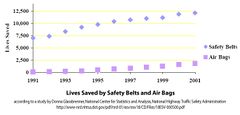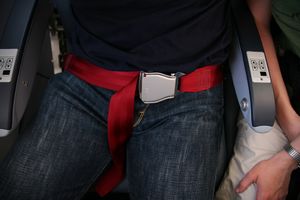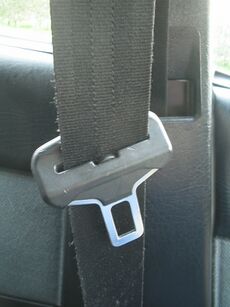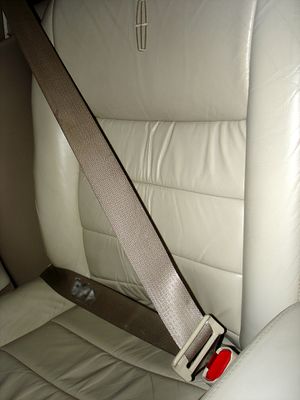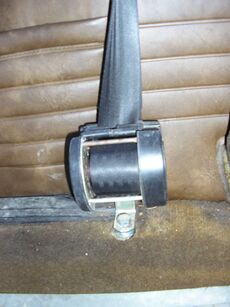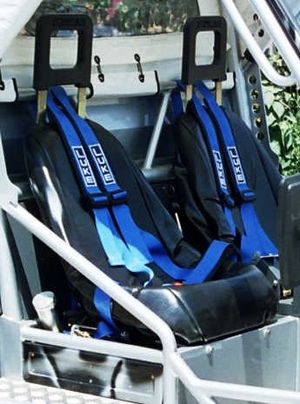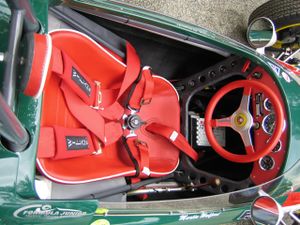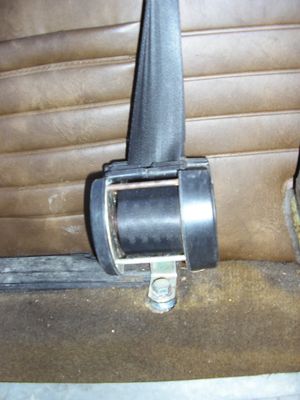حزام أمان
حزام الأمان هو شريط صمم ليحمي راكب العربات من الحركة المؤذية التي تكون نتيجة التصادم أو التوقف المفاجئ.
أحزمة الأمان تهدف تقليل الإصابات بإيقاف مرتديه من الاصطدام الأجزاء القاسية من العربة ويمنع الراكب من أن يقذف خارج العربة.
أحزمة الأمان هي أحد تطبيقات القانوان الأول لنيوتن(الجسم الساكن يبقى ساكنا والجسم المتحرك يستمر في حركه بسرعة منتظمة في خط مستقيم ما لم تؤثر عليه قوة خارجية تجبره على تغيير ذلك) فالجسم قاصر بذاته على تغيير حالته، وهذا ما يفسر ظاهرة (القصور الذاتي)للأجسام المتحركة، فمثلا عندما تتحرك سيارة وعليعا أمتعة غي مثبتة بسرعة منتظمة تكون السيارة والأمتعة في حالة حركة، وعندما تتوقف السيارة فجأة فإن حالة السيارة تتحول من الحركة للسكون بينما تظل الأمتعة غير المثبتة في حالة حركة تبعا لخاصية القصور الذاتي أي أنه لا توحد قوة تغير من حالة حركة الأمتعة بعدما أثرت قوة المكابح(الاحتكاك) على السيارة فغيرت من حالتها، فتسقط الأمتعة، ومن هنا جاءت فكرة عمل أحزمة الأمان.
أنواع أحزمة الأمان
حزام بنقطتين (حـِجـْر)
هو حزام قابل للتعديل يربط حول الخصر ،استعمل كثيراً في السيارات القديمة، أيضا يستعمل هذا النوع من الاحزمة في مقاعد الطائرات
A two-point belt attaches at its two endpoints. A simple strap was first used March 12, 1910, by pilot Benjamin Foulois,[1][2][3] a pioneering aviator with the Aeronautical Division, U.S. Signal Corps, so he might remain at the controls during turbulence.
The Irvin Air Chute Company made the seat belt for use by professional race car driver Barney Oldfield when his team decided the daredevil should have a "safety harness" for the 1923 Indianapolis 500.[4][5][6]
الحـِجـْر
A lap belt is a strap that goes over the waist. This was the most common type of belt prior to legislation requiring three-point belts and is found in older cars. Coaches are equipped with lap belts (although many newer coaches have three-point belts), as are passenger aircraft seats.
University of Minnesota professor James J. (Crash) Ryan was the inventor of, and held the patent for, the automatic retractable lap safety belt. Ralph Nader cited Ryan's work in Unsafe at Any Speed and, following hearings led by Senator Abraham Ribicoff, President Lyndon Johnson signed two bills in 1966 requiring safety belts in all passenger vehicles starting in 1968.[7][8]
Until the 1980s, three-point belts were commonly available only in the front outboard seats of cars; the back seats were often only fitted with lap belts. Evidence of the potential of lap belts to cause separation of the lumbar vertebrae and the sometimes-associated paralysis, or "seat belt syndrome" led to the progressive revision of passenger safety regulations in nearly all developed countries to require three-point belts, first in all outboard seating positions, and eventually in all seating positions in passenger vehicles. Since September 1, 2007, all new cars sold in the U.S. require a lap and shoulder belt in the center rear seat.[9] In addition to regulatory changes, "seat belt syndrome" has led to a liability for vehicle manufacturers. One Los Angeles case resulted in a $45 million jury verdict against Ford; the resulting $30 million judgment (after deductions for another defendant who settled prior to trial) was affirmed on appeal in 2006.[10]
While lap belts are exceedingly rare to spot in modern cars, they are the standard in commercial airliners. The lift-lever style of commercial aircraft buckles allows for the seatbelt to be easily clasped and unclasped, accessible quickly in case of an emergency where a passenger must evacuate, and fulfills the minimum safety requirements provided by the FAA while remaining low-cost to produce.[11]Furthermore, in case of any collision, a passenger in economy class has only around 9 inches for their head to travel forward, meaning restraining the torso and head is relatively unnecessary as the head has little room to accelerate before collision.
وشاح
A "sash" or shoulder harness is a strap that goes diagonally over the vehicle occupant's outboard shoulder and is buckled inboard of their lap. The shoulder harness may attach to the lap belt tongue, or it may have a tongue and buckle completely separate from those of the lap belt. Shoulder harnesses of this separate or semi-separate type were installed in conjunction with lap belts in the outboard front seating positions of many vehicles in the North American market starting at the inception of the shoulder belt requirement of the U.S. National Highway Traffic Safety Administration's (NHTSA) Federal Motor Vehicle Safety Standard 208 on January 1, 1968. However, if the shoulder strap is used without the lap belt, the vehicle occupant is likely to "submarine", or slide forward in the seat and out from under the belt, in a frontal collision. In the mid-1970s, three-point belt systems such as Chrysler's "Uni-Belt" began to supplant the separate lap and shoulder belts in American-made cars, though such three-point belts had already been supplied in European vehicles such as Volvo, Mercedes-Benz, and Saab for some years.
الحزام ثلاثي النقاط
هو حزام الموجود في السيارات الحديثة، يساعد على تشتيت طاقة الجسم المتحرك في التصادم على الصدر، الحوض والأكتاف. حتى عام 1980، الحزام الثلاثي النقاط كان شائع الاستخدام في المقاعد الأمامية فقط.
A three-point belt is a Y-shaped arrangement, similar to the separate lap and sash belts, but unified. Like the separate lap-and-sash belt, in a collision, the three-point belt spreads out the energy of the moving body over the chest, pelvis, and shoulders. Volvo introduced the first production three-point belt in 1959.[12] The first car with a three-point belt was a Volvo PV 544 that was delivered to a dealer in Kristianstad on August 13, 1959. The first car model to have the three-point seat belt as a standard item was the 1959 Volvo 122, first outfitted with a two-point belt at initial delivery in 1958, replaced with the three-point seat belt the following year.[13] The three-point belt was developed by Nils Bohlin, who had earlier also worked on ejection seats at Saab.[14] Volvo then made the new seat belt design patent open in the interest of safety and made it available to other car manufacturers for free.[15][16]
Belt-in-Seat
The Belt-in-Seat (BIS) is a three-point harness with the shoulder belt attached to the seat itself, rather than to the vehicle structure. The first car using this system was the Range Rover Classic, which offered BIS as standard on the front seats from 1970.[17] Some cars like the Renault Vel Satis use this system for the front seats. A General Motors assessment concluded seat-mounted three-point belts offer better protection especially to smaller vehicle occupants,[18] though GM did not find a safety performance improvement in vehicles with seat-mounted belts versus belts mounted to the vehicle body.[19]
Belt-in-Seat type belts have been used by automakers in convertibles and pillarless hardtops, where there is no "B" pillar to affix the upper mount of the belt. Chrysler and Cadillac are well known for using this design. Antique auto enthusiasts sometimes replace original seats in their cars with BIS-equipped front seats, providing a measure of safety not available when these cars were new. However, modern BIS systems typically use electronics that must be installed and connected with the seats and the vehicle's electrical system in order to function properly.[بحاجة لمصدر]
أربع وخمس وست نقاط
Five-point harnesses are typically found in child safety seats and in racing cars. The lap portion is connected to a belt between the legs and there are two shoulder belts, making a total of five points of attachment to the seat. A 4-point harness is similar, but without the strap between the legs, while a 6-point harness has two belts between the legs. In NASCAR, the 6-point harness became popular after the death of Dale Earnhardt, who was wearing a five-point harness when he suffered his fatal crash. As it was first thought that his belt had broken, and broke his neck at impact, some teams ordered a six-point harness in response.[20]
سبع نقاط
Aerobatic aircraft frequently use a combination harness consisting of a five-point harness with a redundant lap belt attached to a different part of the aircraft. While providing redundancy for negative-g maneuvers (which lift the pilot out of the seat), they also require the pilot to unlatch two harnesses if it is necessary to parachute from a failed aircraft.
التكنولوجيا
Locking retractors
The purpose of locking retractors (sometimes called ELR belts, for "Emergency Locking Retractors") is to provide the seated occupant the convenience of some free movement of the upper torso within the compartment while providing a method of limiting this movement in the event of a crash. Starting in 1996, all passenger vehicles were required to lock pre-crash, meaning they have a locking mechanism in the retractor or in the latch plate.[21] Seat belts are stowed on spring-loaded reels called "retractors" equipped with inertial locking mechanisms that stop the belt from extending off the reel during severe deceleration.[22]
There are two main types of inertial seat belt locks. A webbing-sensitive lock is based on a centrifugal clutch activated by the rapid acceleration of the strap (webbing) from the reel. The belt can be pulled from the reel only slowly and gradually, as when the occupant extends the belt to fasten it. A sudden rapid pull of the belt—as in a sudden braking or collision event—causes the reel to lock, restraining the occupant in position. The first automatic locking retractor for seat belts and shoulder harnesses in the U.S. was the Irving "Dynalock" safety device.[23][24] These "Auto-lock" front lap belts were optional on AMC cars with bucket seats in 1967.[25]
A vehicle-sensitive lock is based on a pendulum swung away from its plumb position by rapid deceleration or rollover of the vehicle. In the absence of rapid deceleration or rollover, the reel is unlocked and the belt strap may be pulled from the reel against the spring tension of the reel. The vehicle occupant can move around with relative freedom while the spring tension of the reel keeps the belt taut against the occupant. When the pendulum swings away from its normal plumb position due to sudden deceleration or rollover, a pawl is engaged, the reel locks and the strap restrains the belted occupant in position. Dual-sensing locking retractors use both vehicle G-loading and webbing payout rate to initiate the locking mechanism.
Pretensioners and webclamps
Seat belts in many newer vehicles are also equipped with "pretensioners" or "web clamps", or both.
Pretensioners preemptively tighten the belt to prevent the occupant from jerking forward in a crash. Mercedes-Benz first introduced pretensioners on the 1981 S-Class. In the event of a crash, a pretensioner will tighten the belt almost instantaneously. This reduces the motion of the occupant in a violent crash. Like airbags, pretensioners are triggered by sensors in the car's body, and many pretensioners have used explosively expanding gas to drive a piston that retracts the belt. Pretensioners also lower the risk of "submarining", which occurs when a passenger slides forward under a loosely fitted seat belt.
Some systems also pre-emptively tighten the belt during fast accelerations and strong decelerations, even if no crash has happened. This has the advantage that it may help prevent the driver from sliding out of position during violent evasive maneuvers, which could cause loss of control of the vehicle. These pre-emptive safety systems may prevent some collisions from happening, as well as reduce injuries in the event an actual collision occurs.[26] Pre-emptive systems generally use electric pretensioners, which can operate repeatedly and for a sustained period, rather than pyrotechnic pretensioners, which can only operate a single time.
Webclamps stop the webbing in the event of an accident and limit the distance the webbing can spool out (caused by the unused webbing tightening on the central drum of the mechanism). These belts also often incorporate an energy management loop ("rip stitching") in which a section of the webbing is looped and stitched with special stitching. The function of this is to "rip" at a predetermined load, which reduces the maximum force transmitted through the belt to the occupant during a violent collision, reducing injuries to the occupant.
A study demonstrated that standard automotive three-point restraints fitted with pyrotechnic or electric pretensioners were not able to eliminate all interior passenger compartment head strikes in rollover test conditions.[27] Electric pretensioners are often incorporated on vehicles equipped with precrash systems; they are designed to reduce seat belt slack in a potential collision and assist in placing the occupants in a more optimal seating position.[28] The electric pretensioners also can operate on a repeated or sustained basis, providing better protection in the event of an extended rollover or a multiple collision accident.
Inflatable
The inflatable seat belt was invented by Donald Lewis and tested at the Automotive Products Division of Allied Chemical Corporation.[29] Inflatable seat belts have tubular inflatable bladders contained within an outer cover. When a crash occurs, the bladder inflates with gas to increase the area of the restraint contacting the occupant and also shortening the length of the restraint to tighten the belt around the occupant, improving the protection.[30] The inflatable sections may be shoulder-only or lap and shoulder. The system supports the head during the crash better than a web-only belt. It also provides side impact protection. In 2013, Ford began offering rear-seat inflatable seat belts on a limited set of models, such as the Explorer and Flex.[31]
Automatic
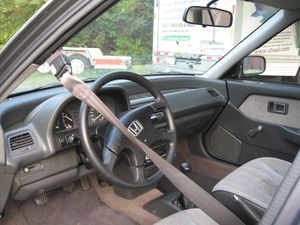
Seat belts that automatically move into position around a vehicle occupant once the adjacent door is closed and/or the engine is started were developed as a countermeasure against low usage rates of manual seat belts, particularly in the United States. The 1972 Volkswagen ESVW1 Experimental Safety Vehicle presented passive seat belts.[32] Volvo tried to develop a passive three point seat belt. In 1973, Volkswagen announced they had a functional passive seat belt.[33] The first commercial car to use automatic seat belts was the 1975 Volkswagen Golf.[34]
Automatic seat belts received a boost in the United States in 1977 when Brock Adams, United States Secretary of Transportation in the Carter Administration, mandated that by 1983 every new car should have either airbags or automatic seat belts.[35][36] There was strong lobbying against the passive restraint requirement by the auto industry.[37] Adams was criticized by Ralph Nader, who said that the 1983 deadline was too late.[38] The Volkswagen Rabbit also had automatic seat belts,[38] and VW said that by early 1978, 90,000 cars had sold with them.[34]
General Motors introduced a three-point non-motorized passive belt system in 1980 to comply with the passive restraint requirement.[39] However, it was used as an active lap-shoulder belt because of unlatching the belt to exit the vehicle.[39] Despite this common practice, field studies of belt use still showed an increase in wearing rates with this door-mounted system.[39] General Motors began offering automatic seat belts on the Chevrolet Chevette.[40][41] However, the company reported disappointing sales because of this feature.[42] For the 1981 model year, the new Toyota Cressida became the first car to offer motorized automatic passive seat belts.[43]
A study released in 1978 by the United States Department of Transportation said that cars with automatic seat belts had a fatality rate of .78 per 100 million miles, compared with 2.34 for cars with regular, manual belts.[44]
In 1981, Drew Lewis, the first Transportation Secretary of the Reagan Administration, influenced by studies done by the auto industry,[45] dropped the mandate;[46] the decision was overruled in a federal appeals court the following year,[47] and then by the Supreme Court.[48] In 1984, the Reagan Administration reversed its course,[49] though in the meantime the original deadline had been extended; Elizabeth Dole, then Transportation Secretary, proposed that the two passive safety restraints be phased into vehicles gradually, from vehicle model year 1987 to vehicle model year 1990, when all vehicles would be required to have either automatic seat belts or driver side air bags.[48] Though more awkward for vehicle occupants, most manufacturers opted to use less expensive automatic belts rather than airbags during this time period.
When driver side airbags became mandatory on all passenger vehicles in model year 1995[بحاجة لمصدر], most manufacturers stopped equipping cars with automatic seat belts. Exceptions include the 1995–96 Ford Escort/Mercury Tracer and the Eagle Summit Wagon, which had automatic safety belts along with dual airbags.[بحاجة لمصدر]
Systems
- Manual lap belt with automatic motorized shoulder belt: When the door is opened, the shoulder belt moves from a fixed point near the seat back on a track mounted in the door frame of the car to a point at the other end of the track near the windshield. Once the door is closed and the car is started, the belt moves rearward along the track to its original position, thus securing the passenger. The lap belt must be fastened manually.
- Manual lap belt with automatic non-motorized shoulder belt: This system was used in American-market vehicles such as the Hyundai Excel and Volkswagen Jetta. The shoulder belt is fixed to the aft upper corner of the vehicle door and is not motorized. The lap belt must be fastened manually.
- Automatic shoulder and lap belts: This system was mainly used in General Motors vehicles, though it was also used on some Honda Civic hatchbacks and Nissan Sentra coupes. When the door is opened, the belts go from a fixed point in the middle of the car by the floor to the retractors on the door. Passengers must slide into the car under the belts. When the door closes, the seat belt retracts into the door. The belts have normal release buttons that are supposed to be used only in an emergency, but in practice are routinely used in the same manner as manual seat belt clasps.[بحاجة لمصدر] This system also found use by American Specialty Cars when they created the 1991-1994 convertible special edition of the Nissan 240SX, a car that traditionally had a motorized shoulder belt.
Disadvantages
Automatic belt systems generally offer inferior occupant crash protection.[50][51] In systems with belts attached to the door rather than a sturdier fixed portion of the vehicle body, a crash that causes the vehicle door to open leaves the occupant without belt protection. In such a scenario, the occupant may be thrown from the vehicle and suffer greater injury or death.[51]
Because many automatic belt system designs compliant with the U.S. passive-restraint mandate did not meet the anchorage requirements of Canada (CMVSS 210) — which were not weakened to accommodate automatic belts — vehicle models that had been eligible for easy importation in either direction across the U.S.-Canada border when equipped with manual belts became ineligible for importation in either direction once the U.S. variants obtained automatic belts and the Canadian versions retained manual belts. Two particular models affected were the Dodge Spirit and Plymouth Acclaim.[52]
Automatic belt systems also present several operational disadvantages. Motorists who would normally wear seat belts must still fasten the manual lap belt, thus rendering redundant the automation of the shoulder belt. Those who do not fasten the lap belt wind up inadequately protected only by the shoulder belt. In a crash, without a lap belt, such a vehicle occupant is likely to "submarine" (be thrown forward under the shoulder belt) and be seriously injured.[بحاجة لمصدر] Motorized or door-affixed shoulder belts hinder access to the vehicle, making it difficult to enter and exit—particularly if the occupant is carrying items such as a box or a purse. Vehicle owners tend to disconnect the motorized or door-affixed shoulder belt to relieve the nuisance when entering and exiting the vehicle, leaving only a lap belt for crash protection.[بحاجة لمصدر] Also, many automatic seat belt systems are incompatible with child safety seats, or only compatible with special modifications.
في المقاعد الخلفية
In 1955 (as a 1956 package), Ford offered lap-only seat belts in the rear seats as an option within the Lifeguard safety package. In 1967, Volvo started to install lap belts in the rear seats. In 1972, Volvo upgraded the rear seat belts to a three-point belt.[53]
In crashes, unbelted rear passengers increase the risk of belted front seat occupants' death by nearly five times.[54][55]
اعتبارات النقل العام
Buses
School buses
In the U.S., six states—California, Florida, Louisiana, New Jersey, New York, and Texas—require seat belts on school buses.[56]
Pros[57][58][59] and cons[60][61][62] have been debated about the use of seat belts in school buses. School buses, which are much bigger than the average vehicle, allow for the mass transportation of students from place to place. The American School Bus Council states in a brief article: "The children are protected like eggs in an egg carton—compartmentalized, and surrounded with padding and structural integrity to secure the entire container." Although school buses are considered safe for mass transit of students, this will not guarantee that the students will be injury-free if an impact were to occur. Seat belts in buses are sometimes believed to make recovering from a roll or tip harder for passengers, as they could be easily trapped in their own safety belts.[63]
In 2015, for the first time, NHTSA endorsed seat belts on school buses.[64]
Motor coaches
In the European Union, all new long-distance buses and coaches must be fitted with seat belts.[65]
Australia has required lap/sash seat belts in new coaches since 1994. These must comply with Australian Design Rule 68, which requires the seat belt, seat and seat anchorage to withstand 20g deceleration and an impact by an unrestrained occupant to the rear.[66]
In the United States, NHTSA now requires lap-shoulder seat belts in new "over-the-road" buses (includes most coaches) starting in 2016.[67]
القطارات
The use of seat belts in trains has been investigated. Concerns about survival space intrusion in train crashes and increased injuries to unrestrained or incorrectly restrained passengers led researchers to discourage the use of seat belts in trains.
- "It has been shown that there is no net safety benefit for passengers who choose to wear 3-point restraints on passenger-carrying rail vehicles. Generally, passengers who choose not to wear restraints in a vehicle modified to accept 3-point restraints receive marginally more severe injuries."[68]
الطائرات
All aerobatic aircraft and gliders (sailplanes) are fitted with four or five-point harnesses, as are many types of light aircraft and many types of military aircraft. The seat belts in these aircraft have the dual function of crash protection and keeping the pilot(s) and crew in their seat(s) during turbulence and aerobatic maneuvers. Passenger aircraft are fitted with lap belts. Unlike road vehicles, passenger aircraft seat belts are not primarily designed for crash protection. Their main purpose is to keep passengers in their seats during events such as turbulence.[69] Many civil aviation authorities require a "fasten seat belt" sign in passenger aircraft that can be activated by a pilot during takeoff, turbulence, and landing.[70][71] The International Civil Aviation Organization recommends the use of child restraints.[72] Some airline authorities, including the UK Civil Aviation Authority (CAA),[73] permit the use of airline infant lap belts [74] (sometimes known as an infant loop or belly belt) to secure an infant under age two sitting on an adult's lap.
تاريخ أحزمة ب
عرض الحزام لأول مرة في السيارات الأمريكيةعام 1947م، وفي عام 1956م وفرت شركة فورد الحزام في السيارات التي ستباع داخل أمريكا، وفي عام 1964م أصبح الحزام صفة قياسية للسيارات الأمريكية. وفي عام 1966م أصبح الحزام الخلفي قياسياً، وفي عام 1967م أصبح الحزام الأمامي إلزامياً، وفي عام 1968م أصبح حزام الكتف إلزامياً.
التنبيه والاجراس والأضواء
بعض السيارات الحديثة مثل آودي,وستروين. بيإمدبليو, فورد, هوندا, هيونداي، مرسيدس-بينز, تويوتا تظهر وميض كتذكير ضوئي وصوت تنبيه مستمر حتى يثبت السائق حزام الأمان.

أنظر ايضاً
- Air bags
- Automobile safety
- Baby transport
- Passive safety device
- Seat belt use rates by country
- Seat belt use rates in the USA
المصادر
- ^ Foulois, Benjamin Delahauf (1980). From the Wright brothers to the astronauts. Arno Press. p. 74. ISBN 9780405122118.
- ^ Pool, William C. (1955). "The Origin of Military Aviation in Texas, 1910–1913". The Southwestern Historical Quarterly. LVIII (January): 342–371. Retrieved 28 March 2019.
- ^ Giles, Barney M. (October 1950). "Early Military Aviation in Texas". The Southwestern Historical Quarterly. LIV (October): 145–146. Retrieved 28 March 2019.
- ^ United States Congress House Committee on Public Works Subcommittee on Roads (1972). "1972 Highway Legislation: Hearings, Ninety-second Congress, Second Session". U.S. Government Printing Office. p. 180. Retrieved 10 September 2020.
- ^ Hedgbeth, Llewellyn. "Development of Automotive Seatbelts". Second Chance Garage. Archived from the original on 2020-11-12. Retrieved 10 September 2020.
- ^ Fischer, Kurt (16 February 2011). "A Supplier's Perspective on Automotive Safety – Past, Present & Future" (PDF). University of Michigan - UMTRI Automotive Safety Conference. Archived from the original (PDF) on 30 October 2015. Retrieved 10 September 2020.
- ^ Mettner, J. (May 2006). ""Crash" Was His Name; Car Safety Was His Game". Minnesota Medicine. 89 (5): 16–7. PMID 16764412. Retrieved 5 September 2020.
- ^ Johnson, Steven (2021). Extra Life (in الإنجليزية) (1st ed.). Riverhead Books. pp. 187–188. ISBN 978-0-525-53885-1.
- ^ "Federal Motor Vehicle Safety Standards; Occupant Crash Protection. Final Rule". nhtsa.dot.gov. Archived from the original on 2010-03-25. Retrieved 2011-02-02.
- ^ "Karlsson v. Ford Motor Co. (2006) 140 CA4th 1202". Continuing Education of the Bar - California "CEB". 27 June 2006. Retrieved 5 September 2020.
- ^ Nosowitz, Dan (2018-01-29). "Decoding the Design of In-Flight Seat Belts". Atlas Obscura (in الإنجليزية). Retrieved 2024-04-26.
- ^ "Volvo Cars airbag celebrates 20 years". Volvoclub.org.uk. 2007-05-26. Retrieved 2009-08-29.
- ^ Lindh, Björn Erik (1986). "The Amazon/120 - Beauty with Brown". Volvo The Cars from the 20s to the 80s. Förlagshuset Norden, Malmö. p. 134. ISBN 91-86442-14-7.
The 1959 model (which appeared in August 1958) had a major innovation in the form of front seat safety belts as standard equipment on all the cars, including the export models. Volvo was the world's first automaker to take this step, even though Ford fitted a "lap" belt on one or other of its cars in the middle of the 50s.
- ^ "Allt om Motor: Trepunktsbältet 50 år". Alltommotor.se. Archived from the original on 2009-08-17. Retrieved 2011-02-02.
- ^ "Three-point seatbelt inventor Nils Bohlin born". History.com. July 15, 2020. Retrieved January 11, 2021.
- ^ "Volvo's Three-Point Safety Belt Celebrates 50 Years of Saving Lives". theautochannel.com (Press release). August 11, 2009. Retrieved January 11, 2021.
- ^ Lankard, Tom. "The first seat offered in the US that incorporated a three-point belt—on the 1990 Mercedes-Benz SL". Editorial.autos.msn.com. Archived from the original on 2014-07-27. Retrieved 2011-02-02.
- ^ "Up Close: Seatbelt safety in question". KHOU News. 20 June 2003. Archived from the original on 12 June 2008.
- ^ "In Search of the Perfect Seat Belt". Archived from the original on 2014-07-27.
- ^ "Earnhardt's death a watershed moment". Sports.espn.go.com. 2011-02-07. Retrieved 2013-09-30.
- ^ "Lock it up! How to Lock a Seat Belt for Car Seat Installation". Car Seats For The Littles. 18 March 2014. Retrieved 6 September 2020.
- ^ Harris, Tom (9 April 2002). "How Seatbelts Work: Extend and Retract". HowStuffWorks.com. Retrieved 6 September 2020.
- ^ "Dynalock". Automobile Engineer. IPC Transport Press. 54 (1): 62. 1964. Retrieved 10 September 2020.
- ^ "An industry grows on safety". Business Week: 14. 1966. Retrieved 10 September 2020.
- ^ "1967 Ambassador brochure". oldcarbrochures.org. p. 17. Retrieved 6 September 2020.
- ^ Ito, Daisuke; Ejima, Susumu; Sukegawa, Yoshihiro; Antona, Jacobo; Ito, Hisao. "Assessment of a Pre-Crash Technology in Frontal Impacts by Using a New Crash Test Sled System with Controllable Pre-Impact Braking" (PDF). National Highway Traffic Safety Administration. Archived from the original (PDF) on 2014-05-06. Retrieved 2014-06-06.
- ^ "Microsoft Word - 2007-01-0709.doc" (PDF). Archived from the original (PDF) on 2013-04-08. Retrieved 2013-09-30.
- ^ "Active Seatbelts". Autoliv.com. Archived from the original on 2013-10-02. Retrieved 2013-09-30.
- ^ U.S. patent 3841654
- ^ Silke, Sharon (2009-11-06). "Ford says inflatable seat belt improves safety, comfort, too". USA Today. Retrieved 2011-04-03.
- ^ "Cool features you can buy now". Consumer Reports: 9. April 2013.
- ^ "Experimental Safety Vehicle". Classicvw.org. Retrieved 2011-02-02.
- ^ "Safety Sells: Chapter 3" (PDF). Archived from the original (PDF) on 2011-07-27. Retrieved 2011-02-02.
- ^ أ ب "Passive-Belt Activity". The New York Times. 1978-03-26.
- ^ "Airbags, seat belts to be mandatory in every car by 1983". Daily Collegian. Penn State. 1977-07-01. Archived from the original on 2012-04-02. Retrieved 2009-12-03.
- ^ "Air Bags, Automatic Seat Belts". The Los Angeles Times. 1977-10-04.
- ^ Stevens, William K. (1977-07-01). "Auto Industry Expresses Reluctance, Resignation Over Air Bag Mandate". The New York Times. p. 18. Retrieved 2009-12-03.
- ^ أ ب Haic, Marty (1979-02-23). "Crusade Continues, But The Intensity Has Mellowed". Boca Raton News. p. 8C. Retrieved 2009-12-03.[dead link]
- ^ أ ب ت Buckling Up: Technologies to Increase Seat Belt Use. Transportation Research Board. 2004. p. 48. Archived from the original. You must specify the date the archive was made using the
|archivedate=parameter. http://onlinepubs.trb.org/onlinepubs/sr/sr278.pdf. Retrieved on 14 December 2017. - ^ "GM Offers Automatic Seat Belts". Chicago Tribune. 1978-06-27. p. 8.
- ^ "GM's Automatic Seat Belts Go on Chevettes". The Los Angeles Times. 1978-06-27.
- ^ "Sales of Automatic Seat Belts Disappointing, Chevrolet Says". Toledo Blade. 1979-02-23. p. 1. Retrieved 2009-12-03.[dead link]
- ^ Stark, Harry A., ed. (1981). Ward's Automotive Yearbook 1981. Ward's Communications. p. 27.
- ^ Girard, Penny (1978-08-31). "Study Finds Automatic Seat Belts, Airbags Save Lives". St. Petersburg Times. p. 1. Retrieved 2009-12-03.[dead link]
- ^ Brody, Jane E. (1981-12-09). "Personal Health". The New York Times. Retrieved 2009-12-03.
- ^ "Automatic seat belt, airbag rules dropped". Chicago Tribune. 1981-10-24. p. 1.
- ^ "Automatic seat belts ordered". Spokane Chronicle. 1982-08-04. p. 28. Retrieved 2009-12-03.[dead link]
- ^ أ ب "Middle Lane: Bags, Belts, and a Loophole". Time. 1984-07-23. Archived from the original on October 29, 2010. Retrieved 2009-12-03.
- ^ "U.S. to require airbags or automatic seat belts". Chicago Tribune. 1984-07-11. p. 1.
- ^ "Chrysler Doubts Air-Bag Claims". The Montreal Gazette. Associated Press. 1977-09-30. Retrieved 2010-09-25.
- ^ أ ب Abeles, Ethan (1998). The Ability of Automakers to Introduce a Costly, Regulated New Technology: A Case Study of Automotive Airbags in the U.S. Light-Duty Vehicle Market (Master's Thesis). Archived from the original on 2010-06-12. Retrieved 2010-09-25.
- ^ "List of Vehicles Admissible From the United States" (PDF). Transport Canada. 2010-07-22. pp. 2, 5, 8. CL9203(E). Archived from the original (PDF) on 2010-08-21.
- ^ "Volvocars corporate website". Archived from the original on May 3, 2015.
- ^ Ichikawa, Masao; Nakahara, Shinji; Wakai, Susumu (January 2002). "Mortality of front-seat occupants attributable to unbelted rear-seat passengers in car crashes". Lancet. 359 (9300): 43–4. doi:10.1016/S0140-6736(02)07279-3. PMID 11809187. S2CID 24162449. Retrieved 6 September 2020.
- ^ Derbyshire, David (2002-01-04). "Unbelted rear passengers 'biggest danger in crash". Telegraph.co.uk. Archived from the original on 2022-01-12. Retrieved 2012-08-31.
- ^ "State laws requiring seat belts in school buses". cga.ct.gov. Retrieved 2016-02-26.
- ^ "It's time for seat belts on school buses". SafeGuardSeat.com. SafeGuard Seating. Retrieved 2 December 2013.
- ^ Spital M, Spital A, Spital R (November 1986). "The compelling case for seat belts on school busses". Pediatrics. 78 (5): 928–32. doi:10.1542/peds.78.5.928. PMID 3763306. S2CID 245091757.
- ^ Albers AC (2001). "Should there be laws mandating seatbelts in all school busses? Writing for the pro position". MCN Am J Matern Child Nurs. 26 (1): 8. doi:10.1097/00005721-200101000-00002. PMID 11198463.
- ^ Begley CE, Biddle AK (1988). "Cost-benefit analysis of safety belts in Texas school buses". Public Health Rep. 103 (5): 479–85. PMC 1478133. PMID 3140273.
- ^ "Pros, Cons of School Bus Seatbelts". Wxia.com. Retrieved 2011-02-02.[dead link]
- ^ Garzon DL (2001). "Should there be laws mandating seatbelts in all school buses? Writing for the con position". MCN Am J Matern Child Nurs. 26 (1): 9. doi:10.1097/00005721-200101000-00003. PMID 11198464.
- ^ "Why Aren't Seat Belts Required on School Buses? | Wonderopolis". www.wonderopolis.org. Archived from the original on January 27, 2016.
- ^ "NHTSA reverses course, now wants seat belts on school buses". Archived from the original on 2016-03-07. Retrieved 2016-03-06.
- ^ "EU law makes seat belts obligatory in long distance buses and coaches". European Public Health Alliance. 2006-07-19. Archived from the original on 14 January 2010. Retrieved 6 January 2010.
- ^ Griffths M; Paine M; Moore R (2005-06-15). "Three point seat belts on coaches - the first decade in Australia" (PDF). U.S. National Highway Traffic Safety Administration. Archived from the original (PDF) on 28 March 2012. Retrieved 15 March 2012.
- ^ "NHTSA Announces Final Rule Requiring Seat Belts on Motorcoaches". NHTSA. Archived from the original on 9 December 2013. Retrieved 3 December 2013.
- ^ "Assessment of Three-point Passenger Restraints (seatbelts) Fitted to Seats on Rail Vehicles" (PDF). Archived from the original (PDF) on 2011-06-05. Retrieved 2011-02-02.
- ^ Dan Nosowitz (29 Jan 2018). "Decoding the Design of In-Flight Seat Belts - Atlas Obscura". Atlas Obscura. Archived from the original on 18 October 2019. Retrieved 18 Oct 2019.
- ^ "Guidance for Turbulence Management" (PDF). International Air Transport Association. 2012. Archived from the original (PDF) on 2016-03-04.
- ^ http://www.gpo.gov/fdsys/pkg/CFR-2012-title14-vol1/pdf/CFR-2012-title14-vol1-sec23-785.pdf[bare URL PDF]
- ^ "ICAO Manual Provides New Recommended Practices For Aircraft Cabin Child Restraint Systems". www.icao.int.
- ^ "Airline seating allocations | UK Civil Aviation Authority".
- ^ "Airplane Restraint Devices: Car Seats, CARES Harness & Lap Belt Rules". 28 August 2012.
- Articles with dead external links from December 2021
- Articles with dead external links from May 2018
- All articles with bare URLs for citations
- Articles with bare URLs for citations from March 2022
- Articles with PDF format bare URLs for citations
- Articles with unsourced statements from August 2013
- Articles with unsourced statements from August 2022
- Articles with unsourced statements from February 2011
- Articles with unsourced statements from September 2010
- Articles with unsourced statements from March 2019
- Articles with hatnote templates targeting a nonexistent page
- Automotive safety technologies
- Vehicle parts
- اختراعات إنگليزية
- معدات أمان

